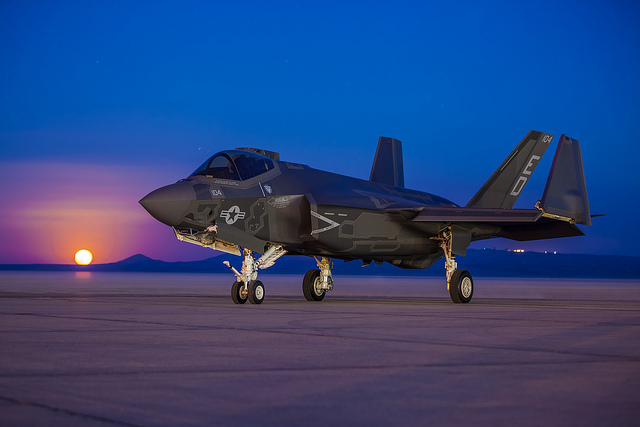The US Navy believes budget pressures and competing priorities could drive it to purchase fewer Lockheed Martin F-35Cs per year in the 2020s, and a worst-case scenario could see it procure as few as 12 aircraft per year, or one squadron.
Naval Air Forces commander Vice Adm Mike Shoemaker says the current plan is to purchase around 20 carrier variants per year in the 2020s, but depending on the resources available, annual output could fall to anywhere between 12 and 20 aircraft.
“I think the current realities of the budget and other priories inside the navy may drive something between those two numbers, but we’re still on the path to [initial operational capability] for our first squadron in 2018,” Shoemaker said at the US Centre for Strategic and International Studies in Washington.
“I’ll keep working as hard as I can with our leadership in the [Pentagon] to ensure we can stay on the path and get out of Classic Hornets and replace them with our F-35C as quick as we can.”
The admiral had two charts with him at the forum, one showing an annual buy of 12 C-models per year through the 2020s and one charting a buy rate of 20. The navy’s latest five-year spending plan shows production peaking at 12 in 2020 as it works toward a total purchase of 369 aircraft to replace its legacy fleet of Boeing F/A-18C/D Hornets.
Talk of decreased production rate comes just one month after incoming chairman of the joint chiefs of staff Gen Joseph Dunford told lawmakers the Pentagon was reviewing how many F-35s it should purchase given new defence strategic guidance and budget pressures, casting doubt about the current requirement for 2,443 aircraft, which was set about two decades ago.
The navy is by far the least enthusiastic recipient of the F-35, with the Marine Corps and Air Force holding firm on their annual buys despite facing similar budget pressures. The C-model was designed specifically for carrier-based operations and has larger wings and horizontal tails as well as stronger landing gear than the A- and B-models.

Lockheed Martin
The reason boils down to simple mathematics, with the navy budgeting $265 million per F-35C in fiscal year 2014 ($1.059 billion in procurement for four jets), but also because the navy has a more modern combat fleet comprised mostly of newer F/A-18 Super Hornets. Even though the average procurement cost is expected to fall to $144 million in 2020 ($1.732 billion to procure 12 jets), it far exceeds the $80 million to $90 million the navy has been budgeting for Boeing Super Hornets over the past few years. A congressional plus-up being considered by Congress for fiscal 2016 would add $1.15 billion in procurement for 12 Super Hornets ($95 million per aircraft).
The air force, on the other hand, relies mostly on aircraft it purchased during the Cold War with the exception of the F-22 Raptor. The Marine Corps’ aviation fleet is in worse shape, since it is stuck with war-weary F/A-18 Hornets and AV-8B Harriers, both decades old.
The navy, however, is faced with a fighter gap and is developing a service life extension programme to keep its Super Hornets in flying condition into the 2030s. The programme will draw on lessons learned from the life extension of the Classic Hornet, and will start overhauling E- and F-models sometime in the early 2020s.
“I think we’ve got a pretty good plan right now to move forward and avoid a significant reduction or gap in our strike fighter inventory as those airplanes come out of service to get repaired and get back into service,” Shoemaker says of upgrading F/A-18s. “It’s not an inconsequential challenge we have ahead of us.”
Lockheed Martin aims to bring the F-35C unit recurring flyaway cost down from $115.4 million in fiscal 2014 to $96 million by 2018, but much of the anticipated savings come from increased quantities. The DOD reportedly paid Lockheed $94.8 million per F-35A airframe in the eighth low-rate initial production lot, $102 million for each F-35B “jump jet,” and $115.7 million per F-35C.
By comparison, the unit recurring flyaway cost for the F/A-18E/F was $59.2 million in fiscal 2013 – the last year the navy requested the Boeing aircraft in its aircraft procurement budget (26 aircraft).
Lockheed expects to ramp up Joint Strike Fighter production to more than 160 aircraft in 2019 including international quantities, and is also eyeing a multi-year block buy for about 450 jets that combines domestic and international orders.
* This story has been updated to provide specific procurement and airframe costs.
Source: Flight International
















